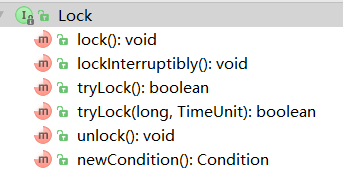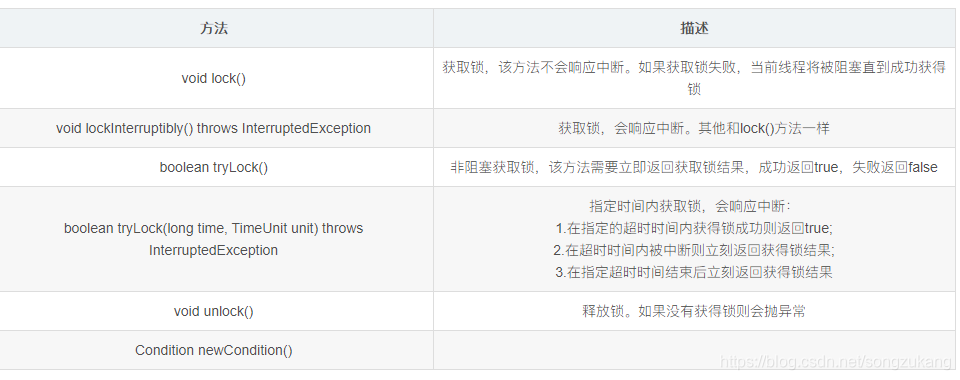ReentrantLock和AQS同步队列
ReentrantLock

lock有这几个方法,

这些类实现的lock。reentrantReadWriteLock属于共享锁,reentrantLock属于互斥锁

下面我们重点分析ReentrantLock.
同步队列(AQS)
同步队列,全称为:AbstractQueuedSynchronizer,AQS依赖内部的一个FIFO双向队列来完成同步状态的管理。在Lock中,这是一个非常重要的核心组件,J.U.C工具包中很多地方都使用到了AQS,所以,如果理解了AQS,那么再去理解ReentrantLock,Condition,CountDownLatch等工具的实现原理,就会非常轻松。

static final class Node {
static final Node SHARED = new Node();
static final Node EXCLUSIVE = null;
static final int CANCELLED = 1;//表示当前线程状态是取消的,需要移除队列
static final int SIGNAL = -1;//表示当前线程正在等待锁,需要中断
static final int CONDITION = -2;//Condition队列有使用到,暂时用不到
static final int PROPAGATE = -3;//CountDownLatch等工具中使用到,暂时用不到
volatile int waitStatus;//节点中线程的状态,默认为0
volatile Node prev;
volatile Node next;
volatile Thread thread;
Node nextWaiter;
...
}
ReentrantLock#lock()
public void lock() {
sync.lock();
}
我们发现这里调用了sync中的一个lock()方法,sync是ReentrantLock类当中的一个组合抽象类,我们知道,AQS是一个同步队列,但是因为AQS只是一个同步队列,并不具备一些业务执行能力,所以通过了另一个Sync来继承AbstractQueuedSynchronizer,并根据不同的业务场景来实现不同的业务逻辑。sync有两个实现类NonfairSync和FairSync,也就是公平锁和非公平锁。
NonfairSync#lock()
private transient Thread exclusiveOwnerThread;
final void lock() {
//cas设置state=1
if (compareAndSetState(0, 1))
//成功的话 保存当前线程为AQS的OwnerThread
setExclusiveOwnerThread(Thread.currentThread());
else
//失败则插入aqs
acquire(1);
}
AQS#compareAndSetState
protected final boolean compareAndSetState(int expect, int update) {
// See below for intrinsics setup to support this
return unsafe.compareAndSwapInt(this, stateOffset, expect, update);
}
上面代码的意思是,如果当前内存中的stateOffset的值和预期值expect相等,则替换为 update值。更新成功返回true,否则返回false。这个操作是原子的,不会出现线程安全问题。
stateOffset是AQS中的一个属性,它在不同的实现中所表达的含义不一样,对于重入锁的实现来说,表示一个同步状态。它有两个含义:
1.当 state=0 时,表示无锁状态
2.当 state>0 时,表示已经有线程获得了锁,也就是state=1,但是因为ReentrantLock允许重入,所以同一个线程多次获得同步锁的时候,state会递增,比如重入 5 次,那么state=5。而在释放锁的时候,同样需要释放5次直到state=0其他线程才有资格获得锁。
目前AQS队列中并没有节点,只是设置了exclusiveOwnerThread。
AQS#acquire
public final void acquire(int arg) {
if (!tryAcquire(arg) && acquireQueued(addWaiter(Node.EXCLUSIVE), arg))
selfInterrupt();
}
Sync#nonfairTryAcquire 非公平锁
protected final boolean tryAcquire(int acquires) {
return nonfairTryAcquire(acquires);
}
final boolean nonfairTryAcquire(int acquires) {
final Thread current = Thread.currentThread();
//0时,表示无锁状态,当 state>0 时,表示已经有线程获得了锁
int c = getState();
if (c == 0) {
//无锁时cas设置锁
if (compareAndSetState(0, acquires)) {
setExclusiveOwnerThread(current);
return true;
}
}
//有锁,但current等于owner说明是重入锁,增加state
else if (current == getExclusiveOwnerThread()) {
int nextc = c + acquires;
if (nextc < 0) // overflow
throw new Error("Maximum lock count exceeded");
setState(nextc);
return true;
}
//有锁,又不是当前线程
return false;
}
Sync#fairTryAcquire 公平锁
protected final boolean tryAcquire(int acquires) {
final Thread current = Thread.currentThread();
int c = getState();
if (c == 0) {
if (!hasQueuedPredecessors() && compareAndSetState(0, acquires)) {
setExclusiveOwnerThread(current);
return true;
}
}
...
}
公平不公平主要体现在tryAcquire方法,公平锁多了一个hasQueuedPredecessors()判断。下面举两个例子
非公平锁
持有锁的线程A正在running,队列中有线程BCD被挂起并等待被唤醒;
在某一个时间点,线程A执行unlock,唤醒线程B;
同时线程E执行lock,这个时候会发生什么?线程B和E拥有相同的优先级,这里讲的优先级是指获取锁的优先级,同时执行CAS指令竞争锁。如果恰好线程E成功了,线程B就得重新挂起等待被唤醒。
公平锁
E执行lock时通过hasQueuedPredecessors()方法发现不是头结点,则不能cas去获取锁。要加到队尾。
AQS#addWaiter(Node)
走到这说明没获取到锁,所以当前线程会被初始化成为一个Node节点。
/**
* Creates and enqueues node for current thread and given mode.
*互斥锁 or 共享锁
* @param mode Node.EXCLUSIVE for exclusive, Node.SHARED for shared
* @return the new node
*/
private Node addWaiter(Node mode) {
Node node = new Node(Thread.currentThread(), mode);
// Try the fast path of enq; backup to full enq on failure
Node pred = tail;
//第一次进来是队列还没构建,所以tail一定为null,不进if
if (pred != null) {
node.prev = pred;
if (compareAndSetTail(pred, node)) {
pred.next = node;
return node;
}
}
enq(node);
return node;
}
private Node enq(final Node node) {
for (;;) {
Node t = tail;
if (t == null) { // tail为null说明要初始化队列
if (compareAndSetHead(new Node())) //初始化head
tail = head; //初始化tail
} else {
node.prev = t; //新节点放队尾,所以原来的tail变为倒数第二个节点
if (compareAndSetTail(t, node)) {//设置当前节点为tail
t.next = node;//所以原来的tail变为倒数第二个节点,所以next指向当前节点
return t;
}
}
}
}
private final boolean compareAndSetHead(Node update) {
return unsafe.compareAndSwapObject(this, headOffset, null, update);
}
/**
* CAS tail field. Used only by enq.
*/
private final boolean compareAndSetTail(Node expect, Node update) {
return unsafe.compareAndSwapObject(this, tailOffset, expect, update);
}
enq第一次循环

enq第二次循环

AQS#acquireQueued
经过addWaiter后已经把Node加到AQS中了,但线程并没有被挂起。所以acquireQueued(Node,arg)方法中会做的两件事:
1、看看前一个节点是不是头节点,如果是的话,就再试一次
2、再试一次如果还是失败了,那么线程正式挂起
final boolean acquireQueued(final Node node, int arg) {
boolean failed = true;
try {
boolean interrupted = false;
for (;;) {
//获取前一个节点
final Node p = node.predecessor();
if (p == head && tryAcquire(arg)) {//如果前一个节点是头结点就再获取一次锁
setHead(node);//设置当前节点是头结点
p.next = null; // 移除原来的head
failed = false;
return interrupted;
}
//还是加锁失败,线程将被挂起
if (shouldParkAfterFailedAcquire(p, node) &&
parkAndCheckInterrupt())
interrupted = true;
}
} finally {
if (failed)
cancelAcquire(node);
}
}
private static boolean shouldParkAfterFailedAcquire(Node pred, Node node) {
int ws = pred.waitStatus;
/*
* static final int CANCELLED = 1;//表示当前线程状态是取消的,需要移除队列
static final int SIGNAL = -1;//表示当前线程正在等待锁,需要中断
static final int CONDITION = -2;//Condition队列有使用到,暂时用不到
static final int PROPAGATE = -3;//CountDownLatch等工具中使用到,暂时用不到
volatile int waitStatus;//节点中线程的状态,默认为0
*/
if (ws == Node.SIGNAL)
// 前一节点已经阻塞,前期节点可直接阻塞
return true;
if (ws > 0) { //ws=1
/*
* 前一节点是取消状态我们要移除取消的节点
*/
do {
node.prev = pred = pred.prev; //prev=prev.prev; node.prev=prev; 当前节点指向前前节点
} while (pred.waitStatus > 0);
pred.next = node;
} else {
/*
* waitStatus =0或PROPAGATE。当前线程被挂起前,需要前节点状态是SINGLE,因为unlock时要唤醒SINGLE的节点去争抢锁
*/
compareAndSetWaitStatus(pred, ws, Node.SIGNAL);
}
return false;
}
因为我们初始化时head里放的是 new Node() waitStatus=0,所以第一次会执行shouldParkAfterFailedAcquire#compareAndSetWaitStatus,将waitStatus设置成-1。第二次循环会走ws == Node.SIGNAL并且shouldParkAfterFailedAcquire返回true,下面继续看parkAndCheckInterrupt()
parkAndCheckInterrupt
private final boolean parkAndCheckInterrupt() {
LockSupport.park(this); //线程走到这将被挂起,下面的return不会执行
return Thread.interrupted();
}
至此完成了lock()操作。
ReentrantLock#unlock()
释放锁时sync没有fair和nofair
public void unlock() {
sync.release(1);
}
public final boolean release(int arg) {
if (tryRelease(arg)) {
Node h = head;
if (h != null && h.waitStatus != 0)
unparkSuccessor(h);
return true;
}
return false;
}
protected final boolean tryRelease(int releases) {
int c = getState() - releases; //获取state-释放的次数
//当前线程才能释放锁
if (Thread.currentThread() != getExclusiveOwnerThread())
throw new IllegalMonitorStateException();
boolean free = false;
//c等于0说明当前线程重入的锁都释放了,目前线程没有持有锁
if (c == 0) {
free = true;
setExclusiveOwnerThread(null);
}
setState(c);
return free;
}
如果tryRelease返回true,AQS的结构如下

unparkSuccessor
private void unparkSuccessor(Node node) {
int ws = node.waitStatus;
if (ws < 0)
compareAndSetWaitStatus(node, ws, 0);
/*
* Thread to unpark is held in successor, which is normally
* just the next node. But if cancelled or apparently null,
* traverse backwards from tail to find the actual
* non-cancelled successor.
*/
Node s = node.next;
如果下一个节点为空或者被取消了
if (s == null || s.waitStatus > 0) {
s = null;
//从尾部找到状态小于等于0的有效节点
for (Node t = tail; t != null && t != node; t = t.prev)
if (t.waitStatus <= 0)
s = t;//注意没有break
}
if (s != null)
LockSupport.unpark(s.thread);
}
从尾部遍历找到有效节点后,unpark唤醒线程。
释放锁后AQS#acquireQueued
final boolean acquireQueued(final Node node, int arg) {
boolean failed = true;
try {
boolean interrupted = false;
for (;;) {
//获取前一个节点
final Node p = node.predecessor();
if (p == head && tryAcquire(arg)) {//如果前一个节点是头结点就再获取一次锁
setHead(node);//设置当前节点是头结点
p.next = null; // 移除原来的head
failed = false;
return interrupted;
}
//还是加锁失败,线程将被挂起
if (shouldParkAfterFailedAcquire(p, node) &&
parkAndCheckInterrupt())
interrupted = true;
}
} finally {
if (failed)
cancelAcquire(node);
}
}
加锁时我们是在parkAndCheckInterrupt()中阻塞的,释放锁后则继续进行循环,会走到“if (p == head && tryAcquire(arg))”这个判断,由于目前state=0,所以节点中的线程设置state=1,设置exclusiveOwnerThread。
private void setHead(Node node) {
head = node;
node.thread = null;
node.prev = null;
}
head中thread=null只因为存到了exclusiveOwnerThread中。
selfInterrupt
public final void acquire(int arg) {
if (!tryAcquire(arg) && acquireQueued(addWaiter(Node.EXCLUSIVE), arg))
selfInterrupt();
}
static void selfInterrupt() {
Thread.currentThread().interrupt();
}
根据acquireQueued中interrupted 的状态看是否执行selfInterrupt()
doAcquireInterruptibly
lock.lockInterruptibly() 中parkAndCheckInterrupt()中断后会抛异常,然后执行cancelAcquire()
private void doAcquireInterruptibly(int arg)
throws InterruptedException {
final Node node = addWaiter(Node.EXCLUSIVE);
boolean failed = true;
try {
for (;;) {
final Node p = node.predecessor();
if (p == head && tryAcquire(arg)) {
setHead(node);
p.next = null; // help GC
failed = false;
return;
}
if (shouldParkAfterFailedAcquire(p, node) &&
parkAndCheckInterrupt())
throw new InterruptedException();
}
} finally {
if (failed)
cancelAcquire(node);
}
}
cancelAcquire
private void cancelAcquire(Node node) {
// Ignore if node doesn't exist
if (node == null)
return;
//1. node不再关联到任何线程
node.thread = null;
//2. 跳过被cancel的前节点,找到一个有效的前节点pred
Node pred = node.prev;
while (pred.waitStatus > 0)
node.prev = pred = pred.prev;
//删除了前面取消的节点
Node predNext = pred.next;
//3. 由于自己也被中断了,所以将node的waitStatus置为CANCELLED
node.waitStatus = Node.CANCELLED;
//4. 如果node是tail,更新tail为pred,并使pred.next指向null
if (node == tail && compareAndSetTail(node, pred)) {
compareAndSetNext(pred, predNext, null);
} else {
int ws;
//5. 如果node既不是tail,又不是head的后继节点
//则将node的前继节点的waitStatus置为SIGNAL
//并使node的前继节点指向node的后继节点
if (pred != head &&
((ws = pred.waitStatus) == Node.SIGNAL ||
(ws <= 0 && compareAndSetWaitStatus(pred, ws, Node.SIGNAL))) && pred.thread != null) {
Node next = node.next;
if (next != null && next.waitStatus <= 0)
compareAndSetNext(pred, predNext, next);
} else {
//6. 当前节点的前置节点是head节点,那就直接把下一个节点唤醒
unparkSuccessor(node);
}
node.next = node; // help GC
}
}





















 902
902











 被折叠的 条评论
为什么被折叠?
被折叠的 条评论
为什么被折叠?








